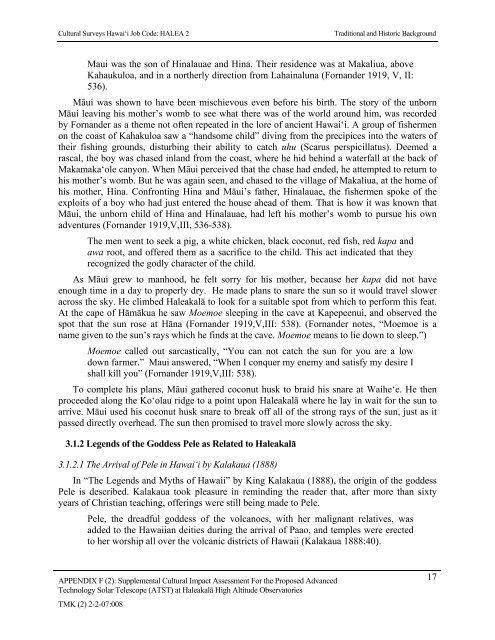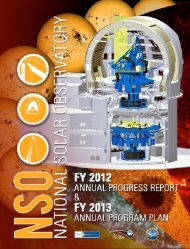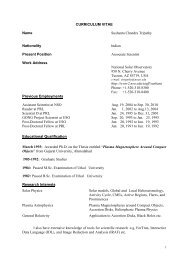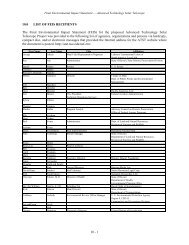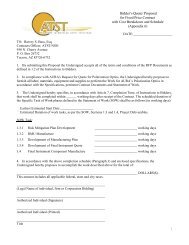F2 - ATST
F2 - ATST
F2 - ATST
You also want an ePaper? Increase the reach of your titles
YUMPU automatically turns print PDFs into web optimized ePapers that Google loves.
Cultural Surveys Hawai‘i Job Code: HALEA 2Traditional and Historic BackgroundMaui was the son of Hinalauae and Hina. Their residence was at Makaliua, aboveKahaukuloa, and in a northerly direction from Lahainaluna (Fornander 1919, V, II:536).Māui was shown to have been mischievous even before his birth. The story of the unbornMāui leaving his mother’s womb to see what there was of the world around him, was recordedby Fornander as a theme not often repeated in the lore of ancient Hawai‘i. A group of fishermenon the coast of Kahakuloa saw a “handsome child” diving from the precipices into the waters oftheir fishing grounds, disturbing their ability to catch uhu (Scarus perspicillatus). Deemed arascal, the boy was chased inland from the coast, where he hid behind a waterfall at the back ofMakamaka‘ole canyon. When Māui perceived that the chase had ended, he attempted to return tohis mother’s womb. But he was again seen, and chased to the village of Makaliua, at the home ofhis mother, Hina. Confronting Hina and Māui’s father, Hinalauae, the fishermen spoke of theexploits of a boy who had just entered the house ahead of them. That is how it was known thatMāui, the unborn child of Hina and Hinalauae, had left his mother’s womb to pursue his ownadventures (Fornander 1919,V,III, 536-538).The men went to seek a pig, a white chicken, black coconut, red fish, red kapa andawa root, and offered them as a sacrifice to the child. This act indicated that theyrecognized the godly character of the child.As Māui grew to manhood, he felt sorry for his mother, because her kapa did not haveenough time in a day to properly dry. He made plans to snare the sun so it would travel sloweracross the sky. He climbed Haleakalā to look for a suitable spot from which to perform this feat.At the cape of Hāmākua he saw Moemoe sleeping in the cave at Kapepeenui, and observed thespot that the sun rose at Hāna (Fornander 1919,V,III: 538). (Fornander notes, “Moemoe is aname given to the sun’s rays which he finds at the cave. Moemoe means to lie down to sleep.”)Moemoe called out sarcastically, “You can not catch the sun for you are a lowdown farmer.” Maui answered, “When I conquer my enemy and satisfy my desire Ishall kill you” (Fornander 1919,V,III: 538).To complete his plans, Māui gathered coconut husk to braid his snare at Waihe‘e. He thenproceeded along the Ko‘olau ridge to a point upon Haleakalā where he lay in wait for the sun toarrive. Māui used his coconut husk snare to break off all of the strong rays of the sun, just as itpassed directly overhead. The sun then promised to travel more slowly across the sky.3.1.2 Legends of the Goddess Pele as Related to Haleakalā3.1.2.1 The Arrival of Pele in Hawai‘i by Kalakaua (1888)In “The Legends and Myths of Hawaii” by King Kalakaua (1888), the origin of the goddessPele is described. Kalakaua took pleasure in reminding the reader that, after more than sixtyyears of Christian teaching, offerings were still being made to Pele.Pele, the dreadful goddess of the volcanoes, with her malignant relatives, wasadded to the Hawaiian deities during the arrival of Paao, and temples were erectedto her worship all over the volcanic districts of Hawaii (Kalakaua 1888:40).APPENDIX F (2): Supplemental Cultural Impact Assessment For the Proposed Advanced 17Technology Solar Telescope (<strong>ATST</strong>) at Haleakalā High Altitude ObservatoriesTMK (2) 2-2-07:008


